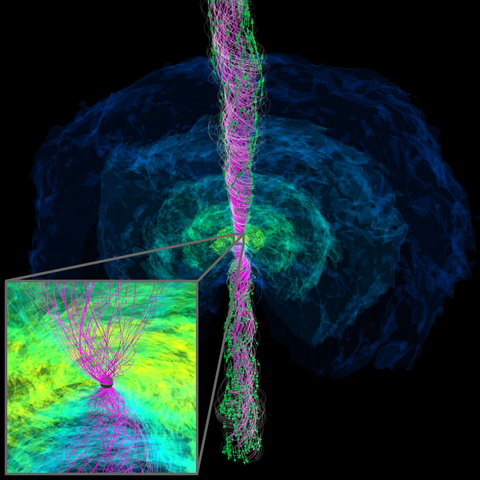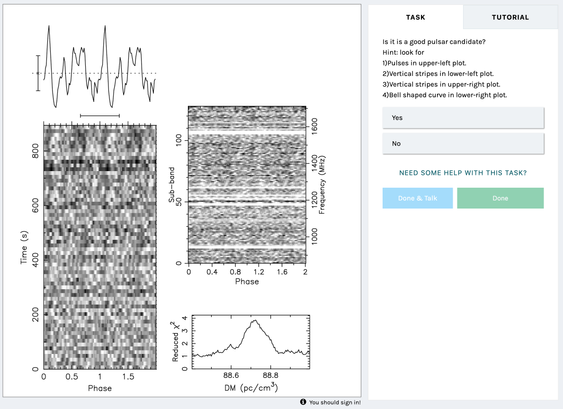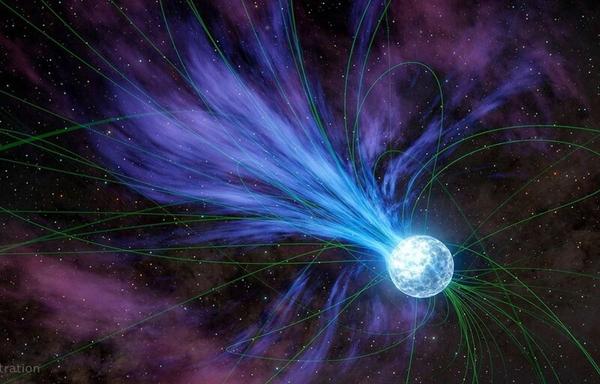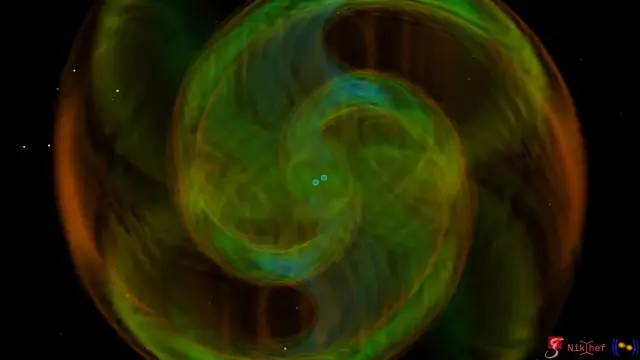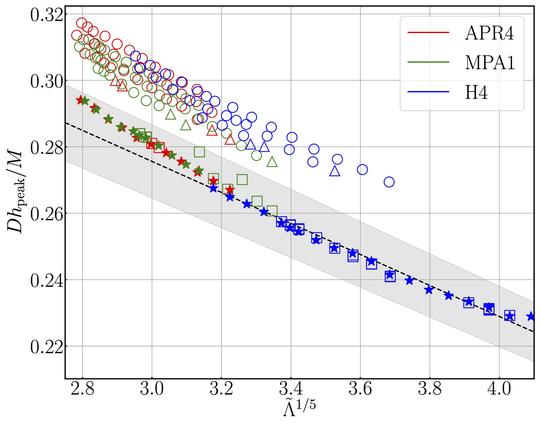NICER Status Updates https://www.nasa.gov/missions/station/nicer-status-updates/ #NASA #InternationalSpaceStationISS #ActiveGalaxies #Astrophysics #BlackHoles #Galaxies #GalaxiesStarsBlackHolesResearch #GoddardSpaceFlightCenter #ISSResearch #NeutronStars #NICERNeutronStarInteriorCompositionExplorer #Pulsars
#neutronStars
More news coverage – this time from phys.org – of our researchers' recent breakthrough simulation of merging neutron stars.
📄 https://phys.org/news/2025-06-simulation-reveals-emergence-jet-binary.html
#NeutronStars #Relativity #Kilonova #Astrophysics #Astronomy #GRB
Neutron Stars – The Most Extreme Things that are not Black Holes
Eccentric ‘Star’ Defies Easy Explanation, NASA’s Chandra Finds https://www.nasa.gov/image-article/eccentric-star-defies-easy-explanation-nasas-chandra-finds/ #NASA #ChandraXRayObservatory #MarshallAstrophysics #MarshallSpaceFlightCenter #NeutronStars #Pulsars #Stars #TheUniverse
Stray thought: pasta chirality. Do all commercially made fusilli / spirali have the same handedness?
A quick search yields a paper on neutron stars, https://doi.org/10.1103/PhysRevD.101.074007 which, although interesting, does not answer my question.
I got a D on a test today. :Blobhaj_Read_MD: D for dense, or more specifically "Extremely Dense" :neobread:
A neutron star would probably get the same rating, right? :neofox_think_owo: I would think so. That implies Hypothesis 1.
It also means that according to science, lesbricks are in the same category of dense as a neutron star. :neofox_science: Thus I can recklessly assume that the mystery remains on whether or not lesbricks are denser than a neutron star. :vlpn_sparkle:
Hypothesis 1: Neutron stars are giant space titties.
Hypothesis 2: Lesbricks and Neutron stars are in the same density category.
Corollary (H1+H2): Lesbricks might have more tricky to interpret mammograms and should make sure they are regularly checking for lumps!
✨ You can make astronomical discoveries without being a researcher 🔭
Join our citizen science project “Einstein@Home: Pulsar Seekers.”
➡️ https://www.zooniverse.org/projects/rsengar/einstein-at-home-pulsar-seekers
All you need is an internet connection, a device with a browser, or the Zooniverse app and you're ready to discover new pulsars.
You will help classify graphical representations of the results of our distributed computing project @einsteinathome.
#CitizenScience #Zooniverse #Astronomy #Astrophysics #Pulsar #NeutronStars
(01 May) The Universe’s Gold May Come From a Totally Unexpected Kind of Star https://s.faithcollapsing.com/ke1ex Archive: ais: https://archive.md/wip/WVYTU ia: https://s.faithcollapsing.com/c970z #magnetars #nasa #neutron-stars #space-&-spaceflight
NASA’s Chandra Diagnoses Cause of Fracture in Galactic “Bone” https://www.nasa.gov/missions/chandra/nasas-chandra-diagnoses-cause-of-fracture-in-galactic-bone/ #NASA #ChandraXRayObservatory #General #MarshallAstrophysics #MarshallSpaceFlightCenter #NeutronStars #Pulsars #Stars #TheUniverse
Five days ago marked the sixth anniversary of the detection of gravitational-wave signal GW190425 (https://astrodon.social/@mpi_grav/114399427478636217). It came from a binary neutron star merger.
These events emit both gravitational waves and electromagnetic signals. This could help solve long-standing questions in fundamental physics research with multi-messenger astrophysics.
For more information on multi-messenger astrophysics, see this article on our portal “Einstein Online”: https://www.einstein-online.info/en/spotlight/multi-messenger-astrophysics/
Where Does Gold Come From? NASA Data Has Clues https://science.nasa.gov/universe/stars/neutron-stars/magnetars/where-does-gold-come-from-nasa-data-has-clues/ #NASA #GoddardSpaceFlightCenter #Magnetars #NeutronStars #TheUniverse #Uncategorized
On this day, six years ago, @LIGO Livingston and Virgo detected an unusual gravitational-wave signal.
GW190425 was only the second signal from (most likely) a neutron star merger. Its distance to Earth was significantly larger and the sky position less precisely determined than for the first such signal (GW170817). Therefore, astronomers did not observe any afterglow in the electromagnetic spectrum.
The total mass of the merging objects was unusually high compared to known double neutron stars.
ℹ️ https://www.aei.mpg.de/142401/news-from-the-gravitational-universe
The publication abuout the observed gravitational-wave signal appeared on 6 January 2020:
📄 https://iopscience.iop.org/article/10.3847/2041-8213/ab75f5
#OnThisDay #OTD #GW190425 #GravitationalWaves #NeutronStars #astronomy #astrodon
NASA’s Roman Mission Shares Detailed Plans to Scour Skies https://www.nasa.gov/missions/roman-space-telescope/nasas-roman-mission-shares-detailed-plans-to-scour-skies/ #NASA #NancyGraceRomanSpaceTelescope #BlackHoles #DarkEnergy #DarkMatter #EarthLikeExoplanets #Exoplanets #Galaxies #GasGiantExoplanets #GoddardSpaceFlightCenter #NeptuneLikeExoplanets #NeutronStars
NASA’s Roman Mission Shares Detailed Plans to Scour Skies https://www.nasa.gov/missions/roman-space-telescope/nasas-roman-mission-shares-detailed-plans-to-scour-skies/ #NASA #NancyGraceRomanSpaceTelescope #BlackHoles #DarkEnergy #DarkMatter #EarthLikeExoplanets #Exoplanets #Galaxies #GasGiantExoplanets #NeptuneLikeExoplanets #NeutronStars #Stars
📣 New Selected Research Highlight:
Modelling 120 binary neutron star mergers
➡️ https://www.aei.mpg.de/1246017/modelling-120-binary-neutron-star-mergers
NASA’s Hubble Tracks a Roaming Magnetar of Unknown Origin science.nasa.gov/missions/hub... #NASA #Astrophysics #AstrophysicsDivision #GoddardSpaceFlightCenter #HubbleSpaceTelescope #Magnetars #NeutronStars #Stars #TheUniverse
NASA's Hubble Tracks a Roaming...
NASA’s Hubble Tracks a Roaming Magnetar of Unknown Origin https://science.nasa.gov/missions/hubble/nasas-hubble-tracks-a-roaming-magnetar-of-unknown-origin/ #NASA #Astrophysics #AstrophysicsDivision #GoddardSpaceFlightCenter #HubbleSpaceTelescope #Magnetars #NeutronStars #Stars #TheUniverse
🔍 In a groundbreaking revelation, neutron stars might just be holding the secret to another dimension—because clearly, black holes were so last decade. 🕳️✨ Meanwhile, scientists juggle their #multiverse theories while demanding you subscribe to yet another newsletter for the "latest cosmic gossip." 🌌📧
https://nautil.us/neutron-stars-hint-at-another-dimension-1202180/ #neutronstars #blackholes #cosmicgossip #scienceupdates #astrophysics #HackerNews #ngated
Neutron Stars Hint at Another Dimension
https://nautil.us/neutron-stars-hint-at-another-dimension-1202180/
#HackerNews #NeutronStars #AnotherDimension #SpaceScience #Physics #News
